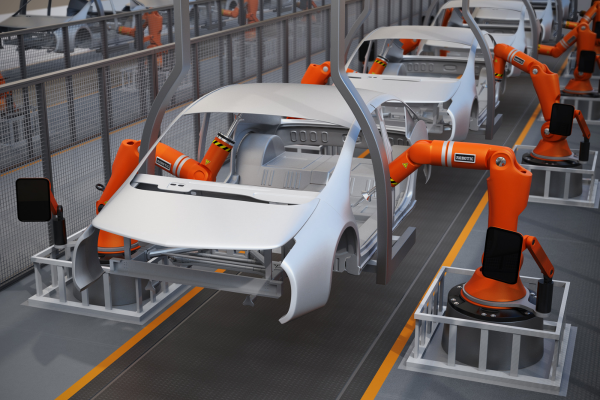Table of contents
- Introduction
- Power Electronics surge in Electric Vehicle.
- Conclusion
- Frequently Asked Questions.
Introduction:
The year 2024 marks a pivotal moment in the evolution of the automotive industry as electric vehicles (EVs) continue to gain traction globally. At the heart of this revolution lies power electronics, a field that is experiencing an unprecedented surge in innovation and adoption.
The automotive industry stands at a crossroads in 2024, poised on the brink of a monumental shift towards sustainable mobility solutions. Electric vehicles (EVs) have emerged as the driving force behind this transformation, challenging the status quo and reshaping the future of transportation. At the heart of the electric revolution lies the rapid advancement of power electronics technology, which is propelling EVs to new heights of efficiency, performance, and accessibility. In this article, we embark on a journey into the electrifying world of 2024, exploring the pivotal role played by power electronics in accelerating the adoption of electric vehicles on a global scale.
In recent years, the automotive landscape has undergone a seismic shift, driven by a convergence of technological innovation, environmental consciousness, and shifting consumer preferences. The growing urgency to combat climate change and reduce dependence on fossil fuels has propelled electric vehicles into the spotlight, positioning them as the vanguard of a cleaner, greener future. Major automotive manufacturers are investing billions of dollars in electrification initiatives, announcing ambitious plans to electrify their vehicle lineups and phase out internal combustion engines. Governments around the world are enacting stringent emissions regulations and offering incentives to promote the adoption of electric vehicles, signalling a clear mandate for a transition towards zero-emission transportation.
Against this backdrop of change and upheaval, power electronics has emerged as the unsung hero of the electric vehicle revolution, driving innovation and unlocking new possibilities for electric mobility. Power electronics encompasses a diverse array of technologies and components, including inverters, converters, on-board chargers, and battery management systems, all of which play integral roles in the propulsion, energy management, and charging infrastructure of electric vehicles. From optimizing energy efficiency and maximizing driving range to enabling fast charging and grid integration, power electronics is the silent enabler behind the seamless operation of electric vehicles.
As we delve deeper into the electrifying drives of 2024, we’ll uncover the latest advancements and breakthroughs in power electronics technology, explore the challenges and opportunities shaping the electric vehicle landscape, and chart a course towards a more sustainable and equitable future of mobility. Join us on this electrifying journey as we illuminate the transformative power of power electronics in driving the electric vehicle revolution of 2024 and beyond.
In this article, we delve into the significant role played by power electronics in driving the advancement of electric vehicles in 2024.
Power Electronics Surge in Electric Vehicle Market.
1. The Rise of Electric Vehicles:

- Electric vehicles have witnessed a remarkable rise in popularity over the past decade, driven by increasing environmental concerns, government incentives, and technological advancements.
- Major automakers are investing heavily in electric vehicle development, aiming to capture a significant share of the burgeoning market.
- Consumers are increasingly opting for electric vehicles due to their lower operating costs, reduced environmental impact, and improved performance compared to traditional internal combustion engine vehicles.
2. Power Electronics: The Backbone of Electric Vehicles:

- Power electronics form the backbone of electric vehicles, facilitating the efficient conversion, control, and distribution of electrical energy within the vehicle’s propulsion system.
- Key components of power electronics in EVs include inverters, converters, on-board chargers, and battery management systems, all of which play critical roles in optimizing energy efficiency and performance.
- Advancements in power electronics technology have led to significant improvements in the efficiency, power density, and reliability of electric vehicle drivetrains, enabling longer driving ranges and faster charging times.
3. Innovations Driving Power Electronics in EVs:

- Silicon carbide and gallium nitride semiconductors have emerged as game-changers in the field of power electronics, offering higher efficiency and temperature tolerance compared to traditional silicon-based components.
- Integrated power modules and advanced packaging techniques are reducing the size, weight, and cost of power electronics systems, making them more suitable for mass adoption in electric vehicles.
- Digital power control algorithms and artificial intelligence-based optimization techniques are enhancing the performance and responsiveness of electric vehicle powertrains, delivering a smoother and more enjoyable driving experience for consumers.
4. Overcoming Challenges:

- Despite the rapid progress in power electronics technology, challenges remain in terms of cost, reliability, and standardization.
- The high cost of advanced power electronic components such as SiC and GaN semiconductors poses a barrier to widespread adoption, especially in mass-market electric vehicles.
- Ensuring the reliability and durability of power electronics systems under harsh operating conditions, including temperature variations and high-voltage stress, remains a priority for automotive manufacturers and suppliers.
- Standardizing interfaces and communication protocols for power electronics components is essential to enable interoperability, compatibility, and scalability across different electric vehicle platforms.
5. Future Outlook:
- The electrification of the automotive industry is expected to accelerate further in the coming years, driven by advancements in power electronics, battery technology, and infrastructure development.
- Continued research and development efforts aimed at improving the efficiency, performance, and cost-effectiveness of power electronics systems will play a crucial role in shaping the future of electric vehicles.
- Collaborations between automotive OEMs, semiconductor manufacturers, and research institutions are key to overcoming technical challenges and unlocking the full potential of power electronics in electric vehicles.
6. Government Initiatives and Regulations:

- Government initiatives and regulations worldwide are playing a significant role in accelerating the adoption of electric vehicles and driving the demand for advanced power electronics solutions.
- Incentives such as tax credits, rebates, and subsidies are encouraging consumers to switch to electric vehicles, while stringent emissions standards are compelling automakers to invest in cleaner and more efficient propulsion technologies.
- Collaborative efforts between governments, industry stakeholders, and research institutions are fostering innovation and driving the development of next-generation power electronics technologies for electric vehicles.
7. Energy Storage and Grid Integration:
- Energy storage systems, including lithium-ion batteries and emerging technologies such as solid-state batteries, are integral components of electric vehicles, enabling them to store and deliver electrical energy efficiently.
- Power electronics play a crucial role in managing the charging and discharging of battery packs, optimizing energy utilization, and ensuring the safety and longevity of the battery system.
- Grid integration technologies such as vehicle-to-grid (V2G) and bidirectional charging are enabling electric vehicles to serve as mobile energy storage units, providing grid stabilization and demand response services while reducing the overall carbon footprint of transportation.
8. Supply Chain and Manufacturing:
- The global supply chain for power electronics components is undergoing rapid transformation to meet the growing demand from the electric vehicle industry.
- Automotive OEMs are forging strategic partnerships with semiconductor manufacturers, component suppliers, and contract manufacturers to secure a stable supply of critical components and accelerate time-to-market for electric vehicles.
- Advanced manufacturing techniques such as additive manufacturing (3D printing) and advanced assembly processes are driving efficiency gains and cost reductions in the production of power electronics modules and systems for electric vehicles.
9. Environmental and Social Impact:

- The widespread adoption of electric vehicles powered by renewable energy sources is expected to significantly reduce greenhouse gas emissions and air pollution, contributing to global efforts to combat climate change and improve air quality.
- The transition to electric mobility is also creating new opportunities for job creation, skill development, and economic growth in sectors such as manufacturing, infrastructure development, and energy services.
- However, challenges related to the environmental impact of battery production, recycling, and disposal must be addressed through sustainable practices and circular economy initiatives to ensure the long-term viability of electric vehicles as a clean transportation solution.
10. Consumer Awareness and Adoption:
- Educating consumers about the benefits of electric vehicles and dispelling common myths and misconceptions is essential to drive greater adoption and acceptance of electric mobility.
- Consumer preferences for electric vehicles are influenced by factors such as driving range, charging infrastructure availability, upfront cost, and perceived reliability.
- Automakers and policymakers need to invest in consumer education campaigns, infrastructure expansion, and innovative financing solutions to overcome barriers to adoption and accelerate the transition to electric mobility.
Conclusion:
In the fast-paced world of 2024, the electrification of transportation has emerged as a beacon of hope in the fight against climate change and air pollution. Electric vehicles, powered by cutting-edge power electronics technology, are leading the charge towards a cleaner, greener future, transforming the way we move and reshaping the automotive industry as we know it.
As we reflect on the electrifying drives of 2024, it becomes clear that power electronics has played a pivotal role in accelerating the adoption of electric vehicles on a global scale. From silicon carbide (SiC) and gallium nitride (GaN) semiconductors to integrated power modules and advanced digital control algorithms, the advancements in power electronics have enabled electric vehicles to achieve unprecedented levels of efficiency, performance, and reliability.
Looking ahead, the future of electric mobility holds immense promise and potential. As governments, industry stakeholders, and consumers continue to prioritize sustainability and innovation, we can expect to see further advancements in power electronics technology, driving greater energy efficiency, faster charging times, and enhanced driving experiences for electric vehicle owners.
However, challenges remain on the path to widespread electrification, including cost constraints, infrastructure limitations, and regulatory complexities. Addressing these challenges will require concerted efforts and collaboration across sectors, as well as continued investment in research, development, and deployment of power electronics solutions for electric vehicles.
Ultimately, the electrifying drives of 2024 are just the beginning of a transformative journey towards a cleaner, smarter, and more sustainable future of mobility. By harnessing the power of power electronics and embracing the promise of electric vehicles, we can pave the way for a world where transportation is not only efficient and convenient but also environmentally responsible and equitable for all.
As we bid farewell to the present and look towards the horizon of tomorrow, let us embark on this journey together, fueled by the spirit of innovation, collaboration, and progress. The road ahead may be challenging, but with determination, ingenuity, and a shared commitment to sustainability, we can drive towards a brighter, electrified future for generations to come.
Frequently Asked Questions:
Power electronics serves as the backbone of electric vehicles, facilitating the efficient conversion, control, and distribution of electrical energy within the vehicle’s propulsion system. It is crucial because it optimizes energy efficiency, enhances performance, and enables key functionalities such as regenerative braking and fast charging.
Advancements in power electronics technology lead to improvements in energy efficiency, driving range, and responsiveness, resulting in a smoother and more enjoyable driving experience for electric vehicle owners. Features such as rapid acceleration, regenerative braking, and seamless power delivery are made possible by sophisticated power electronics systems.
Key innovations driving the surge of power electronics in 2024 include the adoption of silicon carbide (SiC) and gallium nitride (GaN) semiconductors, advanced packaging techniques, digital power control algorithms, and artificial intelligence-based optimization. These innovations contribute to higher efficiency, power density, and reliability of electric vehicle drivetrains.
Automakers are addressing challenges related to cost and reliability through various strategies, including economies of scale, advancements in manufacturing processes, and strategic partnerships with semiconductor manufacturers and suppliers. Additionally, ongoing research and development efforts focus on improving the performance and durability of power electronics systems under harsh operating conditions.
Beyond 2024, power electronics is expected to continue playing a pivotal role in the electrification of transportation, with further advancements in efficiency, performance, and cost-effectiveness. Collaborative efforts between automotive OEMs, semiconductor manufacturers, and research institutions will drive innovation and accelerate the adoption of electric vehicles, paving the way for a sustainable and electrified future of mobility.

